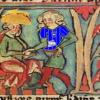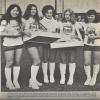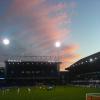| Red Arrows on 21:23 - May 5 with 1006 views | Churchman |
Not terrifying. Just very professional, practiced and skilled at what they do.
The best of the best. |  | |  |
| Red Arrows on 09:55 - May 6 with 573 views | bsw72 |
Now imagine the aircraft and gaps between being larger but with 3 stacks of aircraft vertically totalling up to (and occasionally over) 1000 twin and four engine bombers, forming up over villages across Norfolk and Suffolk from upwards of 20 different bases, with some crews having only days/weeks of experience . . . . |  | |  |
| Red Arrows on 10:04 - May 6 with 549 views | Guthrum |
| Red Arrows on 09:55 - May 6 by bsw72 |
Now imagine the aircraft and gaps between being larger but with 3 stacks of aircraft vertically totalling up to (and occasionally over) 1000 twin and four engine bombers, forming up over villages across Norfolk and Suffolk from upwards of 20 different bases, with some crews having only days/weeks of experience . . . . |
Between a quarter and one third of RAF and USAAF deaths during WWII were due to accidents rather than enemy action.
Inexperienced, poorly rested young pilots under immense strain flying hastily repaired and maintained, heavily loaded aircraft at night or in tight formation, in an era when mechanical unreliability was still a huge issue. |  |
|  |
| Red Arrows on 10:45 - May 6 with 495 views | Radlett_blue |
I saw the Red Arrows perform live before the British GP at Brands Hatch in 1982 & it was breathtaking, especially the opposing passes. I reckon the act may have been toned down slightly on safety grounds, but I doubt anyone would realise that when watching for the first time.
There was a story that they were going to be disbanded on cost grounds a few years ago, but fortunately the MoD realised the associated publicity & benefits to recruitment more than out weighed the financial cost. |  |
|  |
| Red Arrows on 11:26 - May 6 with 443 views | Churchman |
| Red Arrows on 09:55 - May 6 by bsw72 |
Now imagine the aircraft and gaps between being larger but with 3 stacks of aircraft vertically totalling up to (and occasionally over) 1000 twin and four engine bombers, forming up over villages across Norfolk and Suffolk from upwards of 20 different bases, with some crews having only days/weeks of experience . . . . |
Aircrews were actually well trained by the standards of the day. Unlike WW1 it was recognised that the crew (pilots and Navigators especially) were more valuable than the aircraft! Losses in training were heavy, partly because the old, clapped out and unsuitable aeroplanes tended to be lumped on training command/ conversion units and the very nature of learning to fly.
In general, aircraft were not too bad, reliability wise though some were better than others. The Avro Manchester for example was underpowered, the Vulture engines had a tendency to catch fire without enemy help and the escape hatches too small. Good thing Chadwick designed the best bomber of the war virtually in parallel - the superlative Lancaster.
At night, aircraft rarely flew in a formation as such. They flew in a stream by and large - it proved to be a method of Kammhuber’s Himmelbett box defence. Height was key to survival, but different aircraft had different ceilings. The Stirling (first four engine heavy) flew the lowest, Halifax next then the Lancaster. Everyone was happy when Stirlings were on a raid. Attracted flak and fighters like moths to a flame.
Twin engined Whitleys, Hampdens and Wellingtons were phased out of Main Force by the end of 43, though still extensively used for other purposes. Mosquitos were used for specialist stuff, pathfinders, night fighters, intruders, you name it. What a weapon that was. Unique, albeit not the easiest to fly. Drove Goering nuts. Bomber Command was mostly based in and around Lincolnshire.
The American Eighth Air Force was of course based in East Anglia. Following its doctrine, it attacked Germany by day in as you say close ‘box’ formations for mutual defence. The B17 Fortress was more stable and stronger than the B24 Liberator. The latter had the high performance ‘Davis’ wing which made really close formation dangerous, it was also less reliable. Good aeroplane though and both were armed to the teeth. Twin engined Marauders (B26s - known as the widow maker rather unfairly) and B25 Mitchell were used more for specialist stuff.
American crews were extensively trained before they went on ops. But there were still mistakes, collisions, failures in addition to a determined enemy who proved bombers could not survive without fighter escort. A tour for Americans was 25 sorties. The RAF 30 before going to training, other roles, rest before if they wanted it a second tour. Few crews in the height of the battle over Germany got to the end of the tour. The first five sorties and the last few were the most dangerous, but none of it carried great odds for survival.
Added jeopardy came in for Bomber Command when the Luftwaffe introduced Schrage Musik. Upward firing cannon. You could be the best crew on earth but you could die before you knew it because the enemy aircraft could not be spotted so easily.
In terms of the Germans. You flew till you died. That meant their experienced crews drained away and young men were thrown in with little to no experience and provided easy pickings for the allied pilots. By the end of 1944 the 8th could send 2000 bombers and 1000 fighters to Germany.
Bomber Command could send 1000 bombers to Germany plus intruders to hunt night fighters. RAF bombers also had bigger payloads and Lancasters able to undertake specialist raids due to the ability of the aircraft and its enormous uninterrupted bomb bay - Dams, viaducts, Tirpitz, uBoat pens, long range guns you name it.
The sacrifice of aircrews, the skills they had and bravery on all sides was extraordinary. What a waste though. All due to one man’s megalomania. [Post edited 6 May 11:36]
|  | |  |
| Red Arrows on 11:56 - May 6 with 399 views | blueasfook |
| Red Arrows on 10:45 - May 6 by Radlett_blue |
I saw the Red Arrows perform live before the British GP at Brands Hatch in 1982 & it was breathtaking, especially the opposing passes. I reckon the act may have been toned down slightly on safety grounds, but I doubt anyone would realise that when watching for the first time.
There was a story that they were going to be disbanded on cost grounds a few years ago, but fortunately the MoD realised the associated publicity & benefits to recruitment more than out weighed the financial cost. |
Its an optical illusion. they actually dont pass that close to each other but they perform the manouvre at an angle to the crowd that makes it look closer than it is |  |
|  |
| Red Arrows on 12:27 - May 6 with 335 views | mellowblue |
| Red Arrows on 11:56 - May 6 by blueasfook |
Its an optical illusion. they actually dont pass that close to each other but they perform the manouvre at an angle to the crowd that makes it look closer than it is |
yep, it certainly made the crowd gasp. As you say quite a measure of safety involved. Especially as the pass was always pretty near the crowd. |  | |  |
Login to get fewer ads
| Red Arrows on 12:31 - May 6 with 324 views | mellowblue |
| Red Arrows on 11:26 - May 6 by Churchman |
Aircrews were actually well trained by the standards of the day. Unlike WW1 it was recognised that the crew (pilots and Navigators especially) were more valuable than the aircraft! Losses in training were heavy, partly because the old, clapped out and unsuitable aeroplanes tended to be lumped on training command/ conversion units and the very nature of learning to fly.
In general, aircraft were not too bad, reliability wise though some were better than others. The Avro Manchester for example was underpowered, the Vulture engines had a tendency to catch fire without enemy help and the escape hatches too small. Good thing Chadwick designed the best bomber of the war virtually in parallel - the superlative Lancaster.
At night, aircraft rarely flew in a formation as such. They flew in a stream by and large - it proved to be a method of Kammhuber’s Himmelbett box defence. Height was key to survival, but different aircraft had different ceilings. The Stirling (first four engine heavy) flew the lowest, Halifax next then the Lancaster. Everyone was happy when Stirlings were on a raid. Attracted flak and fighters like moths to a flame.
Twin engined Whitleys, Hampdens and Wellingtons were phased out of Main Force by the end of 43, though still extensively used for other purposes. Mosquitos were used for specialist stuff, pathfinders, night fighters, intruders, you name it. What a weapon that was. Unique, albeit not the easiest to fly. Drove Goering nuts. Bomber Command was mostly based in and around Lincolnshire.
The American Eighth Air Force was of course based in East Anglia. Following its doctrine, it attacked Germany by day in as you say close ‘box’ formations for mutual defence. The B17 Fortress was more stable and stronger than the B24 Liberator. The latter had the high performance ‘Davis’ wing which made really close formation dangerous, it was also less reliable. Good aeroplane though and both were armed to the teeth. Twin engined Marauders (B26s - known as the widow maker rather unfairly) and B25 Mitchell were used more for specialist stuff.
American crews were extensively trained before they went on ops. But there were still mistakes, collisions, failures in addition to a determined enemy who proved bombers could not survive without fighter escort. A tour for Americans was 25 sorties. The RAF 30 before going to training, other roles, rest before if they wanted it a second tour. Few crews in the height of the battle over Germany got to the end of the tour. The first five sorties and the last few were the most dangerous, but none of it carried great odds for survival.
Added jeopardy came in for Bomber Command when the Luftwaffe introduced Schrage Musik. Upward firing cannon. You could be the best crew on earth but you could die before you knew it because the enemy aircraft could not be spotted so easily.
In terms of the Germans. You flew till you died. That meant their experienced crews drained away and young men were thrown in with little to no experience and provided easy pickings for the allied pilots. By the end of 1944 the 8th could send 2000 bombers and 1000 fighters to Germany.
Bomber Command could send 1000 bombers to Germany plus intruders to hunt night fighters. RAF bombers also had bigger payloads and Lancasters able to undertake specialist raids due to the ability of the aircraft and its enormous uninterrupted bomb bay - Dams, viaducts, Tirpitz, uBoat pens, long range guns you name it.
The sacrifice of aircrews, the skills they had and bravery on all sides was extraordinary. What a waste though. All due to one man’s megalomania. [Post edited 6 May 11:36]
|
Very good piece, Churchman, I appreciate the time spent doing it.
You can see why after application , the selection process was very much along the line of what sort of temperament the potential trainee had as to what arm of the RAF he would be trained for. Bomber crews had to be solid, reliable, steadfast characters given what was involved. |  | |  |
| Red Arrows on 14:54 - May 6 with 236 views | bsw72 |
| Red Arrows on 11:26 - May 6 by Churchman |
Aircrews were actually well trained by the standards of the day. Unlike WW1 it was recognised that the crew (pilots and Navigators especially) were more valuable than the aircraft! Losses in training were heavy, partly because the old, clapped out and unsuitable aeroplanes tended to be lumped on training command/ conversion units and the very nature of learning to fly.
In general, aircraft were not too bad, reliability wise though some were better than others. The Avro Manchester for example was underpowered, the Vulture engines had a tendency to catch fire without enemy help and the escape hatches too small. Good thing Chadwick designed the best bomber of the war virtually in parallel - the superlative Lancaster.
At night, aircraft rarely flew in a formation as such. They flew in a stream by and large - it proved to be a method of Kammhuber’s Himmelbett box defence. Height was key to survival, but different aircraft had different ceilings. The Stirling (first four engine heavy) flew the lowest, Halifax next then the Lancaster. Everyone was happy when Stirlings were on a raid. Attracted flak and fighters like moths to a flame.
Twin engined Whitleys, Hampdens and Wellingtons were phased out of Main Force by the end of 43, though still extensively used for other purposes. Mosquitos were used for specialist stuff, pathfinders, night fighters, intruders, you name it. What a weapon that was. Unique, albeit not the easiest to fly. Drove Goering nuts. Bomber Command was mostly based in and around Lincolnshire.
The American Eighth Air Force was of course based in East Anglia. Following its doctrine, it attacked Germany by day in as you say close ‘box’ formations for mutual defence. The B17 Fortress was more stable and stronger than the B24 Liberator. The latter had the high performance ‘Davis’ wing which made really close formation dangerous, it was also less reliable. Good aeroplane though and both were armed to the teeth. Twin engined Marauders (B26s - known as the widow maker rather unfairly) and B25 Mitchell were used more for specialist stuff.
American crews were extensively trained before they went on ops. But there were still mistakes, collisions, failures in addition to a determined enemy who proved bombers could not survive without fighter escort. A tour for Americans was 25 sorties. The RAF 30 before going to training, other roles, rest before if they wanted it a second tour. Few crews in the height of the battle over Germany got to the end of the tour. The first five sorties and the last few were the most dangerous, but none of it carried great odds for survival.
Added jeopardy came in for Bomber Command when the Luftwaffe introduced Schrage Musik. Upward firing cannon. You could be the best crew on earth but you could die before you knew it because the enemy aircraft could not be spotted so easily.
In terms of the Germans. You flew till you died. That meant their experienced crews drained away and young men were thrown in with little to no experience and provided easy pickings for the allied pilots. By the end of 1944 the 8th could send 2000 bombers and 1000 fighters to Germany.
Bomber Command could send 1000 bombers to Germany plus intruders to hunt night fighters. RAF bombers also had bigger payloads and Lancasters able to undertake specialist raids due to the ability of the aircraft and its enormous uninterrupted bomb bay - Dams, viaducts, Tirpitz, uBoat pens, long range guns you name it.
The sacrifice of aircrews, the skills they had and bravery on all sides was extraordinary. What a waste though. All due to one man’s megalomania. [Post edited 6 May 11:36]
|
Key is standards of the day - considering that primary, basic, advanced and transition training only came to around 250 hrs of flight training in WW2. I was making more of a reference to the fact that Red Arrows crew would have to have accumulated upwards of 1,500 hrs of fast jet experience alone before being accepted into the squadron.
Am involved in a local WW2 airfield society, get involved in a lot of walks and talks etc. Regularly have relatives of the US Crews come over, mostly children, grand and great grand children these days. Sometimes they bring the diaries with them, which make emotional reading.
What never ceases to amaze me is the fact that in 1939 there were ~100 military airbases in the UK (includes fighter, bomber and flying boat) and by 1945 there were ~720!! The USAAF alone had around half a million men and women stationed on their bases, let alone the RAF.
A lot of the bases from late 1940 onwards used rubble from the bombed cities as hardcore for the runways, which then ironically from the 1950s onwards were dug up and used hard hardcore for the "new" British motorway network. The M25 is built on top of a lot of rubble on which the Liberators, Fortresses and Lancasters took off and landed on during those war years. Remember that when you head up and down the motorways. [Post edited 6 May 14:58]
|  | |  |
| Red Arrows on 15:08 - May 6 with 221 views | Steve_M |
| Red Arrows on 10:45 - May 6 by Radlett_blue |
I saw the Red Arrows perform live before the British GP at Brands Hatch in 1982 & it was breathtaking, especially the opposing passes. I reckon the act may have been toned down slightly on safety grounds, but I doubt anyone would realise that when watching for the first time.
There was a story that they were going to be disbanded on cost grounds a few years ago, but fortunately the MoD realised the associated publicity & benefits to recruitment more than out weighed the financial cost. |
One of the great things about the number of airbases in East Anglia during the 80s was the number of open days at both RAF and USAF bases. It was great as a kid to see the planes up close on the ground and the aerial displays.
There was a pretty constant stream of military aircraft flying around normally too. It's not the same there these days and London doesn't tend to see military aircraft outside of events but I did enjoy sitting in a pub near Keswick a few weeks ago and watching a load of F15s on manoeuvres.
I think you're right on the plan to cut the Red Arrows, must have been late 70s as I remember reading about it in some publication which must have been a decade or so later. |  |
|  |
| Red Arrows on 16:08 - May 6 with 173 views | stonojnr |
| Red Arrows on 11:56 - May 6 by blueasfook |
Its an optical illusion. they actually dont pass that close to each other but they perform the manouvre at an angle to the crowd that makes it look closer than it is |
Thesedays it is, back in the 80s, late 70s they flew close enough to the crowd you'd see how close they got.
That's about 15ft horizontal sep, about half a wings worth at about 150ft off the ground closing speed of 700mph

But they actually went even lower than that...

Yeah wouldn't get away with that thesedays. |  | |  |
| Red Arrows on 17:07 - May 6 with 113 views | Churchman |
| Red Arrows on 12:31 - May 6 by mellowblue |
Very good piece, Churchman, I appreciate the time spent doing it.
You can see why after application , the selection process was very much along the line of what sort of temperament the potential trainee had as to what arm of the RAF he would be trained for. Bomber crews had to be solid, reliable, steadfast characters given what was involved. |
If anyone wants to know what it’s like to do selection and training, Geoff Wellum’s book First Light is the best. It’s the only one I’ve ever read that really tells you what it feels like and just how demanding it was. This isn’t just my view. A former Wing Commander friend of mine totally agrees.
It was rigorous in 1940, much the same in the 70s and probably much more so now. To do pilot selection, then training was quite brutal; pressured and you were assessed throughout; kicked out the moment you didn’t measure up. There was more to it than pure flying ability and you are right in that different temperaments and skills were key in whether you were posted to Fighter, Bomber or Coastal Command, Transport etc.
Training time was shortened for RAF pilots in 1940 when the situation was desperate but that was pretty counter productive as it just meant the pilot would be held back for more training on Squadron or they faced losing him immediately (the film Battle of Britain correctly shows that). As the situation eased, training increased, including utilising fantastic facilities in Canada, US.
For bomber crew selection, they would be all bunged in a room and if you liked the look of say a Bomb Aimer or Nav, you’d ask him. Sort of natural selection. Crude but effective. The efficiency of the crew was often the difference between life and death and that’s where the Pilot’s temperament and abilities came in.
You could always tell a Fighter Command pilot from Bomber Command. The Fighter lads always had the top button undone.
Another little known curious fact: Spitfire streamlining was determined using split peas. Flush rivets were expensive and made production slower. So they made a Spitfire with flush rivets, glued split peas over it. They then test flew the aeroplane. Removed some, flew it again. They did this repeatedly till they found the best performance compromise between standard and flush rivets.
Lastly, the Short Stirling looks odd for two reasons. Firstly Shorts made flying boats and it actually looks like a cut down one and was heavily over engineered accordingly. Secondly, it was designed to an Air Ministry spec that’d fit it in a hanger. That means the wings were too small which in turn meant less height.
Shorts knew this, went back to the ministry with an upgrade proposal. But they were told fulfil the contract as was knowing the Halifax (early versions a disappointment) and Lancaster were coming on stream. |  | |  |
| Red Arrows on 17:10 - May 6 with 109 views | b1079blue |
While I have no doubt the pilots are well trained and professional I feel we love the red arrows because:
A) they are British
B) they are Red
What is the purpose of the R.As?
If it is to go on jollies around the world then all well and good. However if its to promote the raf a d inspire the next generation of pilots they do a crap job. Having seen them at airshows the ground frew or p.r team sit in their tent hiding behind their ray bans and jump suits not engaging with the public. Compare that to a wing walker team that were out in the crowds giving out photos talking and actively talking to kids and their parents.
Unfortunately the reds in my opinion still have that aloof image.
I |  | |  |
| Red Arrows on 17:13 - May 6 with 96 views | Churchman |
| Red Arrows on 16:08 - May 6 by stonojnr |
Thesedays it is, back in the 80s, late 70s they flew close enough to the crowd you'd see how close they got.
That's about 15ft horizontal sep, about half a wings worth at about 150ft off the ground closing speed of 700mph

But they actually went even lower than that...

Yeah wouldn't get away with that thesedays. |
That’s some picture! A Folland Gnat! Great looking little aeroplane.
They served between mid 50s through to late 70s. Designed as a low cost lightweight fighter it fulfilled a training role and was sold in good numbers for export. Made a wonderful racket too! |  | |  |
| Red Arrows on 17:33 - May 6 with 72 views | Coastalblue |
| Red Arrows on 17:07 - May 6 by Churchman |
If anyone wants to know what it’s like to do selection and training, Geoff Wellum’s book First Light is the best. It’s the only one I’ve ever read that really tells you what it feels like and just how demanding it was. This isn’t just my view. A former Wing Commander friend of mine totally agrees.
It was rigorous in 1940, much the same in the 70s and probably much more so now. To do pilot selection, then training was quite brutal; pressured and you were assessed throughout; kicked out the moment you didn’t measure up. There was more to it than pure flying ability and you are right in that different temperaments and skills were key in whether you were posted to Fighter, Bomber or Coastal Command, Transport etc.
Training time was shortened for RAF pilots in 1940 when the situation was desperate but that was pretty counter productive as it just meant the pilot would be held back for more training on Squadron or they faced losing him immediately (the film Battle of Britain correctly shows that). As the situation eased, training increased, including utilising fantastic facilities in Canada, US.
For bomber crew selection, they would be all bunged in a room and if you liked the look of say a Bomb Aimer or Nav, you’d ask him. Sort of natural selection. Crude but effective. The efficiency of the crew was often the difference between life and death and that’s where the Pilot’s temperament and abilities came in.
You could always tell a Fighter Command pilot from Bomber Command. The Fighter lads always had the top button undone.
Another little known curious fact: Spitfire streamlining was determined using split peas. Flush rivets were expensive and made production slower. So they made a Spitfire with flush rivets, glued split peas over it. They then test flew the aeroplane. Removed some, flew it again. They did this repeatedly till they found the best performance compromise between standard and flush rivets.
Lastly, the Short Stirling looks odd for two reasons. Firstly Shorts made flying boats and it actually looks like a cut down one and was heavily over engineered accordingly. Secondly, it was designed to an Air Ministry spec that’d fit it in a hanger. That means the wings were too small which in turn meant less height.
Shorts knew this, went back to the ministry with an upgrade proposal. But they were told fulfil the contract as was knowing the Halifax (early versions a disappointment) and Lancaster were coming on stream. |
Just wanted to second First Light, an incredible book and probably document for that era. |  |
|  |
| Red Arrows on 17:35 - May 6 with 61 views | Lord_Lucan |
| Red Arrows on 10:45 - May 6 by Radlett_blue |
I saw the Red Arrows perform live before the British GP at Brands Hatch in 1982 & it was breathtaking, especially the opposing passes. I reckon the act may have been toned down slightly on safety grounds, but I doubt anyone would realise that when watching for the first time.
There was a story that they were going to be disbanded on cost grounds a few years ago, but fortunately the MoD realised the associated publicity & benefits to recruitment more than out weighed the financial cost. |
I’ve seen them quite a few times and they are always magnificent.
Best time though was at Dartmouth Regatta when they fly up the river.
Brilliant stuff. |  |
|  |
| Red Arrows on 18:08 - May 6 with 16 views | Churchman |
| Red Arrows on 17:10 - May 6 by b1079blue |
While I have no doubt the pilots are well trained and professional I feel we love the red arrows because:
A) they are British
B) they are Red
What is the purpose of the R.As?
If it is to go on jollies around the world then all well and good. However if its to promote the raf a d inspire the next generation of pilots they do a crap job. Having seen them at airshows the ground frew or p.r team sit in their tent hiding behind their ray bans and jump suits not engaging with the public. Compare that to a wing walker team that were out in the crowds giving out photos talking and actively talking to kids and their parents.
Unfortunately the reds in my opinion still have that aloof image.
I |
Well, you have a point, but I’m always going to disagree. They do promote the RAF, the country and especially excellence in their way. Nobody does it better. They entertain the crowds and are flippin brilliant at what they do. Anything that encourages kids to get into aviation is fine by me.
Cost effective? In pounds and pence terms probably not but heck, they cheer a dull old world a little as yesterday showed.
Maybe they could do more on the mingling PR front but as serving service personnel I’m guessing they don’t see it that way.
A definite ‘keep’ for me. Not a particularly adequate response on my part and please forgive my bias, given flying (especially aerobatic) is the next best thing to ‘you know what’. |  | |  |
| |